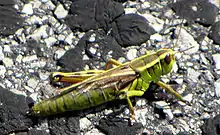Melanoplus bivittatus
Melanoplus bivittatus, the two-striped grasshopper, is a poikilothermic[1] species of grasshopper belonging to the genus Melanoplus. It is commonly found in North America,[2] with high quantities inhabiting Canadian prairies and farmland.[3]
| Melanoplus bivittatus | |
|---|---|
 | |
| Female M. bivittatus | |
| Scientific classification | |
| Domain: | Eukaryota |
| Kingdom: | Animalia |
| Phylum: | Arthropoda |
| Class: | Insecta |
| Order: | Orthoptera |
| Suborder: | Caelifera |
| Family: | Acrididae |
| Subfamily: | Melanoplinae |
| Genus: | Melanoplus |
| Species: | M. bivittatus |
| Binomial name | |
| Melanoplus bivittatus (Say, 1825) | |
| Subspecies | |
| |
Identification
A relatively large species with sizes ranging from 30 to 55 mm.[4] A pair of pale yellow stripes running along the top of its body from above its eyes to the hind tip of its wings help to easily identify this species. This characteristic also gives this species its other common name the yellow-striped grasshopper.[4] The species also has a yellowish green coloration throughout its body due to chromoprotein and carotenoid.[5] The rest of the body looks similar to that of most grasshopper species, with enlarged hind legs for jumping and two pairs of wings, with one set overlapping the other.
Life cycle
During the winter, eggs are laid in the soil and hatch by late April to early May.[3] At optimal conditions (25 °C, very moist), Melanoplus bivittatus will stop morphogenesis at around 21 days.[6] Once morphogenesis is stopped, the eggs go into a state of diapause, with development continuing again in spring.[6] Once temperatures are warm enough the eggs start hatching. Once hatching starts, the maximum rate of hatching occurs between the 10th and 13th day.[6] At the end of development, a Melanoplus bivittatus individual will have gone through five instars.[3]
Mating and reproduction
Melanoplus bivittatus participate in long hours of mating, with some copulation lasting up to 10 hours.[7] The mating rituals of M.bivittatus are similar to that of red-legged grasshoppers (Melanoplus femurrubrum) in that both species receive and obtain nuptial gifts, in this case spermatophores[7] Spermatophores are provided during the entire copulation period, which tends to be dominated mostly by male activity.[7] Not only does long periods of copulation increase the likelihood of transferring genes, but time spent in copola can be very productive for sperm and nutrient transfer.[7] Once the females have mated with a male they can delay mating for up to 21 days.[7] Females will often refrain from rejecting males due to the benefits gained from the protein and fitness from eating the spermatophore.[7]
Diet
Melanoplus bivittatus are polyphagous, which means they are capable of eating a wide variety of food.[2] The main source of food they rely on are plants such as forbs and lentil crops.[2] This species is commonly seen eating many different types of crops on farms across North America.[2] In times of food shortage, this species has been known to cannibalize one another.[8] During times of colder weather (below 25 °C) Melanoplus bivittatus will not feed since fecal production is low and excrete can not be expelled.[2] This species of Orthoptera require a diet with linoleic acid or unsaturated fatty acids, since these acids keep the organism's wings from crumpling.[5]
Pest
Orthoptera are known pests to agricultural environments. Some species can completely ruin crops and have detrimental economic effects on farmers.[3] Melanoplus bivittatus can cause crop damage all through their life cycle.[3] Not only do M. bivittatus damage crops, but they tend to eat the reproductive parts of the plants (sepals, flowers, immature and mature pods), so the likelihood of regeneration or reproduction is slim.[3]
References
- Harrison, Jon F.; Phillips, John E.; Gleeson, Todd T. (March 1991). "Activity Physiology of the Two-Striped Grasshopper, Melanoplus bivittatus: Gas Exchange, Hemolymph Acid-Base Status, Lactate Production, and the Effect of Temperature". Physiological Zoology. 64 (2): 451–472. doi:10.1086/physzool.64.2.30158185. ISSN 0031-935X. S2CID 87926207.
- Harrison, Jon F.; Fewell, Jennifer H. (May 1995). "Thermal Effects on Feeding Behavior and Net Energy Intake in a Grasshopper Experiencing Large Diurnal Fluctuations in Body Temperature". Physiological Zoology. 68 (3): 453–473. doi:10.1086/physzool.68.3.30163779. ISSN 0031-935X. S2CID 85834005.
- Olfert, O.; Slinkard, A. (1999). "Grasshopper (Orthoptera: Acrididae) damage to flowers and pods of lentil (Lens culinaris L.)". Crop Protection. 18 (8): 527–530. doi:10.1016/s0261-2194(99)00056-3.
- "Species Melanoplus bivittatus - Two-striped Grasshopper".
- Nayar, J. K. (January 1964). "THE NUTRITIONAL REQUIREMENTS OF GRASSHOPPERS: I. REARING OF THE GRASSHOPPER, MELANOPLUS BIVITTATUS (SAY), ON A COMPLETELY DEFINED SYNTHETIC DIET AND SOME EFFECTS OF DIFFERENT CONCENTRATIONS OF B-VITAMIN MIXTURE, LINOLEIC ACID, AND β-CAROTENE". Canadian Journal of Zoology. 42 (1): 11–22. doi:10.1139/z64-002. ISSN 0008-4301.
- Church, N. S.; Salt, R. W. (June 1952). "Some Effects of Temperature on Development and Diapause in Eggs of Melanoplus Bivittatus (say) (orthoptera: Acrididae)". Canadian Journal of Zoology. 30 (3): 173–184. doi:10.1139/z52-015. ISSN 0008-4301.
- Hinn, J.C. (1999). "Male and female mating strategies as they relate to the spermatheca in Melanoplus bivittatus (Orthoptera: Acrididae)". North Carolina State University: 1–42.
{{cite journal}}: Cite journal requires|journal=(help) - Gangwere, S. K. (1961). "A monograph on food selection in Orthoptera". Transactions of the American Entomological Society. 2 (87): 67–230.
External links
- Two-striped Grasshopper, Agriculture and Rural Development, Gov. of Alberta
- Two-striped Grasshopper, Talk about Wildlife
- Species Melanoplus bivittatus - Two-Striped Grasshopper, BugGuide
- Two-Striped Grasshopper, The Backyard Arthropod Project
